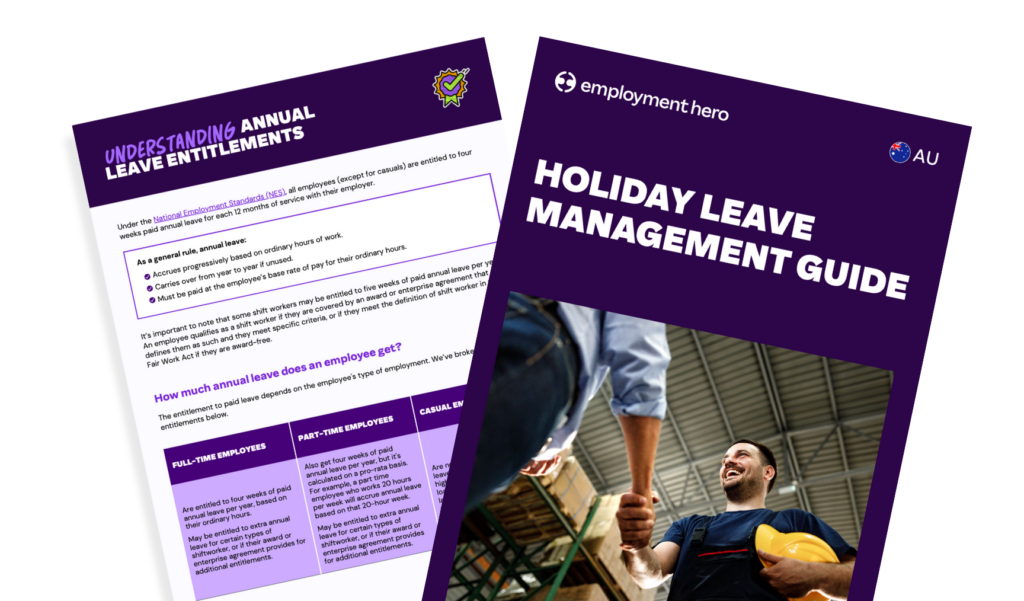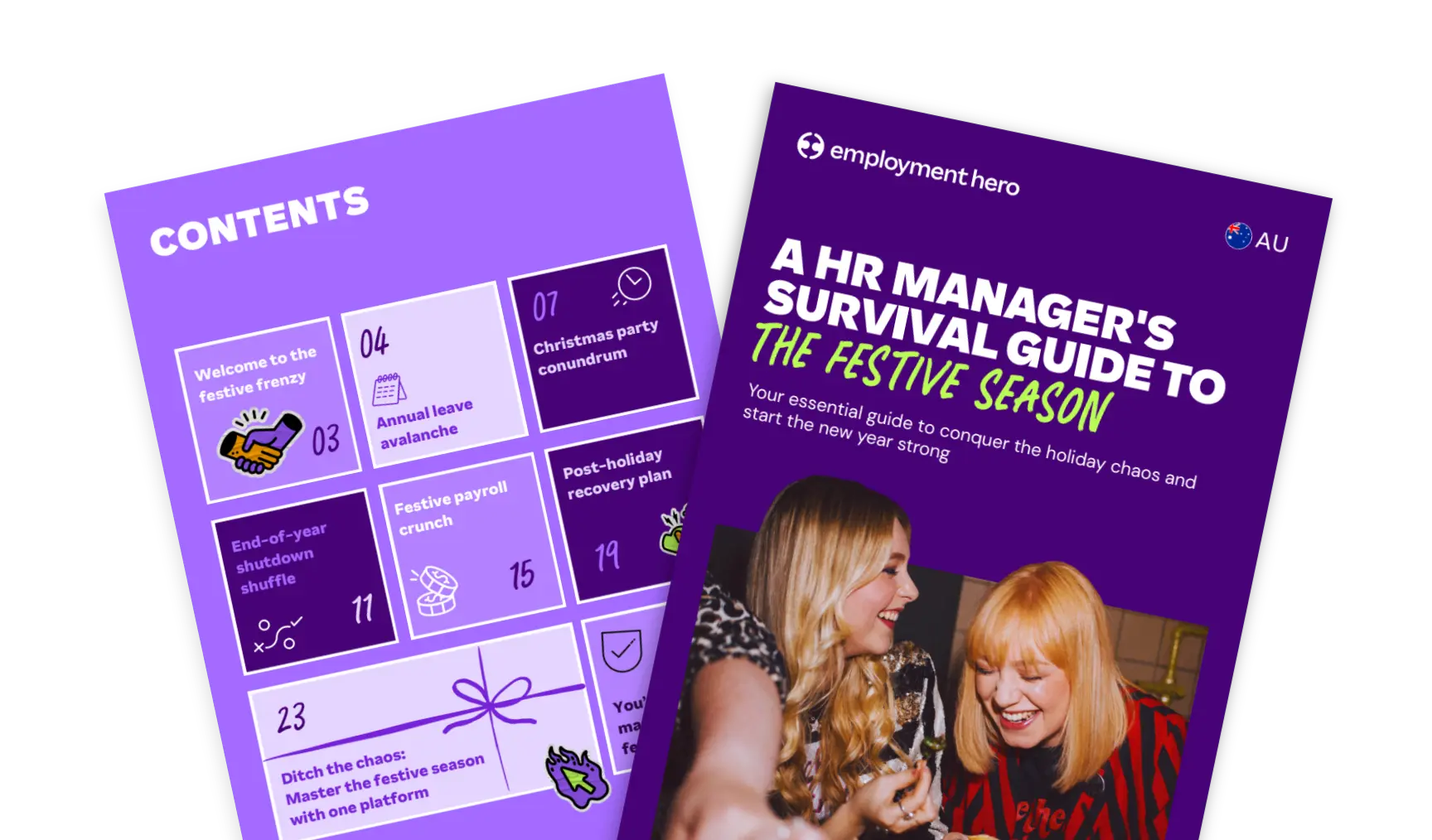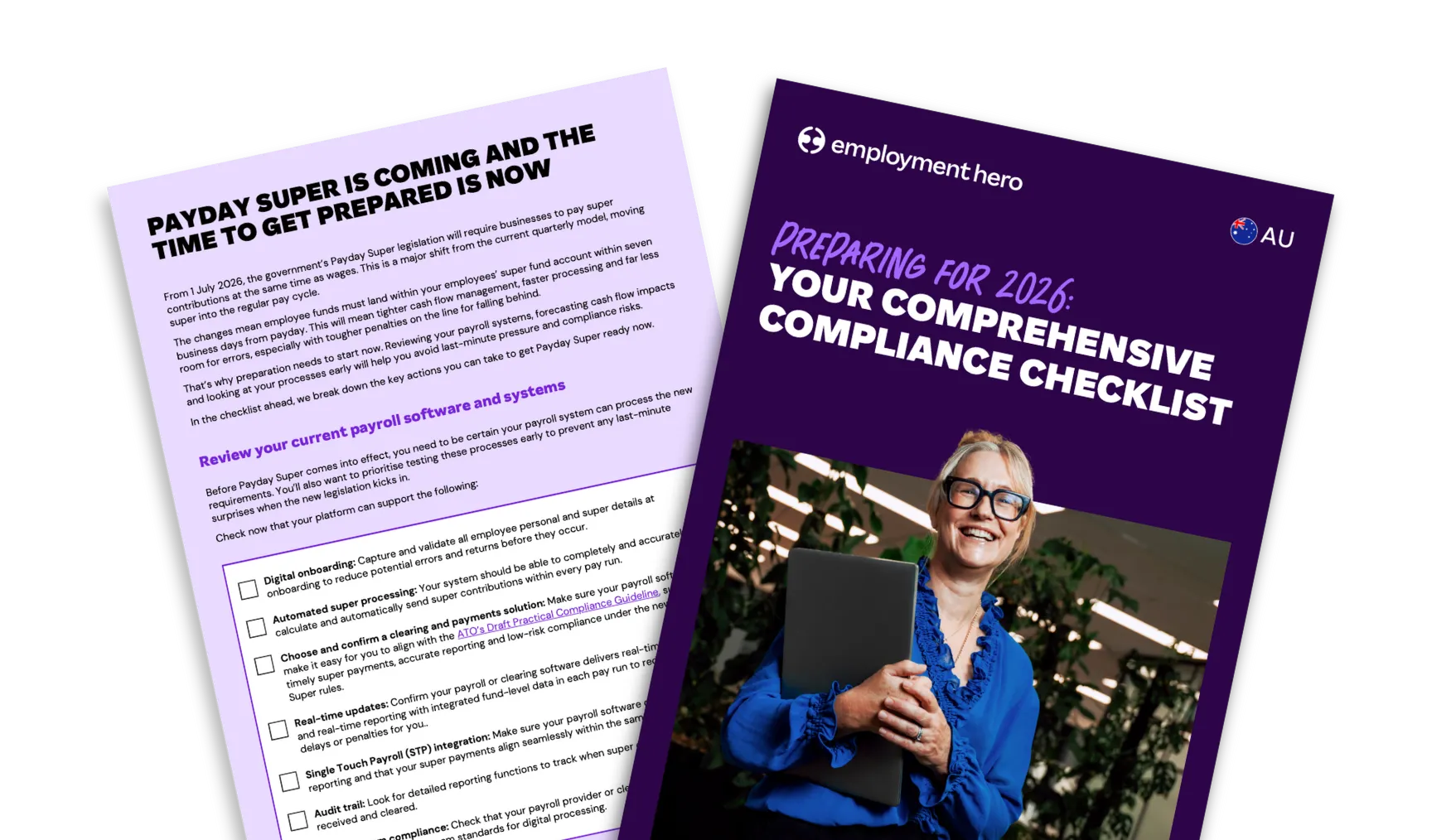Holiday leave guide for Australian employers
Published
Holiday leave guide for Australian employers
Published

The holiday season is around the corner, and with it comes the annual challenge of managing employee leave. Between balancing requests, staying on top of compliance and keeping the business running, it can quickly feel like a juggling act. But the good news is that it doesn’t have to be.
With some forward planning and the right tools, managing leave can be a simple, straight-forward process, even for the busiest teams. When your team has transparency and your systems do the heavy lifting, everyone wins. Your people get the breaks they deserve, and your business keeps running smoothly through the busiest time of the year.
What’s in the holiday leave management guide?
Navigating leave entitlements can be tricky, especially during peak holiday periods. This guide provides a clear roadmap for Australian employers. We’ll cover everything from the basics of annual leave to the specifics of accrual, calculating pay, and managing requests. This guide gives you the tools you need to manage holiday leave confidently.
In here, you’ll information on:
- Understanding annual leave entitlements
- Understanding public holiday entitlements
- How to manage leave requests
- How to manage shut-down periods
- Common leave scenarios (and how to handle them)
- And a holiday leave communication letter template
What is annual leave?
Under the Fair Work Act 2009, annual leave is a paid entitlement that allows an employee to take time off work while still receiving their ordinary pay.
It’s one of the National Employment Standards (NES), which are the minimum standards of employment for employees covered by the national workplace relations system. This time off is crucial for employee wellbeing, helping them rest and recharge away from the workplace.

Annual leave and other types of leave
It’s important to distinguish annual leave from other leave types to ensure correct application and payment.
Personal/carer’s leave
Also known as sick and carer’s leave, this is for when an employee is unwell, injured or needs to care for an immediate family or household member. This is separate from paid annual leave.
Long service leave
This entitlement is for employees who have worked for the same employer for a long period. The rules vary by state and territory. We’ve laid out the entitlements for each jurisdiction in our Guide to Long Service Leave Entitlements article.
Unpaid parental leave
Eligible employees can take unpaid leave when a child is born or adopted. For more information on parental leave, download our Guide to Understanding Parental Leave.
Community service leave
This allows employees to take unpaid leave for voluntary emergency management activities or jury duty.
Leave for family and domestic violence
The NES provides for 10 days of paid family and domestic violence leave in a 12-month period.An effective leave policy should clearly outline the different types of leave available to your team. If you’re looking to introduce a leave policy, download our Leave Policy Template here.

How is annual leave calculated?
Annual leave accrues based on an employee’s ordinary hours, not overtime.
For example:
- A full-time employee working 38 hours per week accrues approximately 2.923 hours of leave per week.
- A part-time employee working 20 hours per week accrues leave on a pro-rata basis, so would accrue approximately 1.538 hours of leave per week.
Formula:
(Employee’s ordinary hours per week × 4 weeks) ÷ 52 weeks = the weekly accrual rate
It’s important to note that some shift workers may be entitled to five weeks of paid annual leave per year. An employee qualifies as a shift worker if they are covered by an award or enterprise agreement that defines them as such and they meet specific criteria, such as working a certain number of Sundays or public holidays.
Award-free employees are entitled to 5 weeks of annual leave if the employee is employed in business in which shifts are continuously rostered 24 hours a day for 7 days a week and they: (a) are regularly rostered to work those shifts; and (b) regularly work on Sundays and public holidays.
In addition, some awards have a five week annual leave entitlement as standard, such as the Nurses Award. A shiftworker under the Nurses Award will get an additional (sixth) week of annual leave on top of this.
How much annual leave does an employee get?
The entitlement to paid leave depends on the employee’s type of employment.
| Full-time employees | Part-time employees | Casual employees |
|---|---|---|
| Are entitled to four weeks of paid annual leave per year, based on their ordinary hours.May be entitled to extra annual leave for certain types of shiftworker or if their award or enterprise agreement provides for additional entitlements. | Also get four weeks of paid annual leave per year, but it’s calculated on a pro-rata basis. For example, a part time employee who works 20 hours per week will accrue annual leave based on that 20-hour week.May be entitled to extra annual leave for certain types of shiftworker or if their award or enterprise agreement provides for additional entitlements. | Are not entitled to paid annual leave. Instead, they are paid a higher hourly rate (a casual loading) to compensate for the lack of entitlements like annual and personal leave. |
Accrual of annual leave
Annual leave accrues progressively throughout the year based on the number of ordinary hours an employee works. It starts accumulating from the employee’s first day and is added to their balance with each pay period.
Accrued annual leave continues to build up when an employee is on:
- Paid annual leave or personal/carer’s leave.
- Long service leave.
- Community service leave.
Leave does not typically accrue during periods of unpaid leave, such as unpaid parental leave, unless specified otherwise in an award or enterprise agreement.
Who is entitled to annual leave?
All employees, except for casuals, are entitled to paid annual leave under the NES.
This applies to both full-time and part time employees, regardless of whether their employment is governed by a modern award, enterprise agreement or just an employment contract. Their entitlement stands from the moment they commence work with your business.

When can holiday leave be taken?
Employees can request to take annual leave at any time that is agreed upon with their employer. An employer must not unreasonably refuse an employee’s request. What is considered “unreasonable” depends on factors like the employee’s needs, the operational needs of the business, the amount of notice given and the amount of leave the employee has accrued.
Can employees take leave during probation?
Yes, an employee can request and take accrued annual leave during their probation period. An employer cannot unreasonably refuse the request.
Can employees take leave during notice periods?
Yes, employees can take leave during their notice period, but it depends on the type of leave and whether the employer approves it.
If an employee has accrued annual leave, they can request to use it during their notice period. However, the employer has the right to approve or decline the request, just as they would at any other time.
It’s generally best for both parties to discuss and agree on what works for the business and the employee.
An example of a reasonable approach to taking annual leave during a notice period
Alex, a full-time employee, resigns and gives four weeks’ notice. He has five days of annual leave accrued and asks to take three of those days off during his notice period to attend a family event.
His manager reviews the request and considers a few factors. Upcoming deadlines, team workload and whether Alex’s absence would cause major disruption. Because the business can manage without him for those few days and his work can be properly handed over in time, the manager agrees to the leave request.
This is a reasonable and fair approach. Alex gets to use his accrued entitlement and finish his employment on a positive note, while the business maintains continuity.
By contrast, if an employee requested several weeks of annual leave during their notice period, leaving no time for a proper handover, it would be reasonable for the employer to decline the request.
Can employers direct employees to take leave?
As you head into the end-of-year period, it’s important to understand how rules and entitlements change depending on whether your business is operating, shutting down or reducing staff.
If you plan a shutdown and are directing employees to take annual leave, Fair Work states the direction must be:
- Reasonable
- In writing
- Comply with the relevant award or enterprise agreement
If your modern award or agreement doesn’t include shutdown clauses, you can’t force annual leave, but you can arrange it by mutual agreement, including agreeing on leave in advance or unpaid leave.
In no circumstances can an employer require an employee to take unpaid leave without their agreement. If you have annual shutdowns at Christmas time it is a good idea to ensure employees have enough accrued annual leave to cover the shutdown period.
If your business is working over the period (e.g. retail or hospitality), then you may ask employees to work overtime or on public holidays, but again, it must be a reasonable request, considering their notice, their role and their personal commitments.
Can employees take unpaid leave if they have paid leave available?
If an employee still has paid leave entitlements available, they can’t choose to take unpaid leave instead, unless their employer agrees.
Employers and employees can mutually agree to unpaid leave in special circumstances. For example, if the employee wants to save their paid leave for a later date or has personal reasons for needing extra time off.

What payments are required during annual leave?
When an employee takes annual leave, they’re entitled to receive their base rate of pay for their ordinary hours of work. This is the same rate they’d earn if they were working. This includes any regular allowances, loadings or penalties that are part of their usual pay, but it doesn’t include overtime, bonuses or commission.
Many awards and enterprise agreements also require an annual leave loading, typically 17.5%, to recognise that employees may miss out on penalty rates or overtime while on leave. Employers should always check the applicable award or agreement to confirm the correct rate.
During a temporary business shutdown (like over Christmas or the New Year), employees who are directed to take annual leave must still be paid their ordinary pay and any applicable leave loading. If an employee doesn’t have enough accrued leave to cover the shutdown, they may be able to take unpaid leave by agreement, or in some cases, receive paid leave in advance if both parties agree in writing.
The most important part here is making sure that all payments during leave, whether it’s ordinary, loaded or by agreement, comply with the Fair Work Act and any relevant awards or agreements.
How is leave pay handled at termination?
When an employment relationship ends, you must pay out any unused accrued annual leave as part of the employee’s final pay.
This payment is calculated at the employee’s final base rate of pay, as if they had taken the leave during employment. This includes any leave loading that would have been payable (if applicable).
You can use an annual leave payout calculator to simplify this process.
What is annual leave provision?
From an accounting perspective, annual leave provision is the practice of recognising outstanding employee leave entitlements as a liability on your business’s balance sheet.
Because annual leave is a future cost that the business is obligated to pay, it must be accounted for. Properly tracking this liability is essential for accurate financial reporting and managing cash flow.
Excessive annual leave
In many modern awards, an employee is considered to have an excessive leave balance if they have accrued more than eight weeks of annual leave (or 10 weeks for some shift workers). Many modern awards include terms that allow an employer to direct an employee to take leave to reduce this balance.
This often involves a consultation process and giving the employee sufficient notice. Encouraging staff to take their annual leave is a proactive way to prevent balances from becoming excessive, while also giving your team time off to recharge.
For award-free employees, they can be directed to take annual leave where it is reasonable to do so. This would include circumstances where an employee has an excessive annual leave balance, although there is no strict definition of what “excessive annual leave” means for award-free employees.
Cashing out annual leave
Under the Fair Work Act, an employee can “cash out” a portion of their annual leave entitlement if their award or enterprise agreement allows for it. Award or agreement free employees can also do this if it’s agreed upon with their employer.
The rules generally include:
- A written agreement must be made each time leave is cashed out.
- The employee must have at least four weeks of annual leave left after the cash out.
- The payment must be for the full amount the employee would have received if they took the leave.
Download the full guide now
Managing leave entitlements is an important responsibility for every Australian employer. And with the right systems and tools in place, you can move beyond manual tracking and compliance worries.
Using a dedicated leave management software can automate accruals, simplify requests and make sure you always meet your public holiday entitlements and other obligations.
Disclaimer: The information in this guide is current as at 27 October 2025, and has been prepared by Employment Hero Pty Ltd (ABN 11 160 047 709) and its related bodies corporate (Employment Hero). The views expressed in this guide are general information only, are provided in good faith to assist employers and their employees, and should not be relied on as professional advice. The Information is based on data supplied by third parties. While such data is believed to be accurate, it has not been independently verified and no warranties are given that it is complete, accurate, up to date or fit for the purpose for which it is required. Employment Hero does not accept responsibility for any inaccuracy in such data and is not liable for any loss or damages arising either directly or indirectly as a result of reliance on, use of or inability to use any information provided in this factsheet. You should undertake your own research and to seek professional advice before making any decisions or relying on the information in this guide.
Register for the guide
Related Resources
-
 Read more: HR Managers: Don’t just survive the festive season, master it
Read more: HR Managers: Don’t just survive the festive season, master itHR Managers: Don’t just survive the festive season, master it
Make year-end easier: manage leave, payroll, parties and shutdowns with confidence. Get practical tips for Australian SMEs. Download the free…
-
 Read more: Preparing for 2026: Your Compliance Checklist
Read more: Preparing for 2026: Your Compliance ChecklistPreparing for 2026: Your Compliance Checklist
Get your business ready for the 1 July 2026 changes. See practical steps for Payday Super, cash flow planning and…
-
 Read more: Monthly business budget template for employers
Read more: Monthly business budget template for employersMonthly business budget template for employers
Plan your monthly income and expenses with our free monthly business budget template. Download today to track cash flow and…























